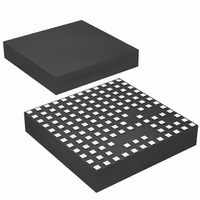LTM4601AHVEV#PBF Linear Technology, LTM4601AHVEV#PBF Datasheet - Page 14

LTM4601AHVEV#PBF
Manufacturer Part Number
LTM4601AHVEV#PBF
Description
IC DC/DC UMODULE 12A 133-LGA
Manufacturer
Linear Technology
Series
µModuler
Type
Point of Load (POL) Non-Isolatedr
Datasheet
1.LTM4601AHVEVPBF.pdf
(30 pages)
Specifications of LTM4601AHVEV#PBF
Design Resources
LTM4601AHV Spice Model
Output
0.6 ~ 5 V
Number Of Outputs
1
Power (watts)
60W
Mounting Type
Surface Mount
Voltage - Input
4.5 ~ 28 V
Package / Case
133-LGA
1st Output
0.6 ~ 5 VDC @ 12A
Size / Dimension
0.59" L x 0.59" W x 0.11" H (15mm x 15mm x 2.8mm)
Power (watts) - Rated
60W
Operating Temperature
-40°C ~ 85°C
Efficiency
95%
Lead Free Status / RoHS Status
Lead free / RoHS Compliant
3rd Output
-
2nd Output
-
LTM4601AHV
APPLICATIONS INFORMATION
Run Enable
The RUN pin is used to enable the power module. The
pin has an internal 5.1V Zener to ground. The pin can be
driven with a logic input not to exceed 5V.
The RUN pin can also be used as an undervoltage lock out
(UVLO) function by connecting a resistor divider from the
input supply to the RUN pin:
Power Good
The PGOOD pin is an open-drain pin that can be used to
monitor valid output voltage regulation. This pin monitors
a ±10% window around the regulation point and tracks
with margining.
COMP Pin
This pin is the external compensation pin. The module
has already been internally compensated for most output
voltages. Table 2 is provided for most application require-
ments. A spice model will be provided for other control
loop optimization.
PLLIN
The power module has a phase-locked loop comprised
of an internal voltage controlled oscillator and a phase
detector. This allows the internal top MOSFET turn-on
to be locked to the rising edge of the external clock. The
frequency range is ±30% around the operating frequency
of 850kHz. A pulse detection circuit is used to detect a
clock on the PLLIN pin to turn on the phase lock loop.
The pulse width of the clock has to be at least 400ns and
2V in amplitude. During the start-up of the regulator, the
phase-lock loop function is disabled.
INTV
An internal low dropout regulator produces an internal
5V supply that powers the control circuitry and DRV
for driving the internal power MOSFETs. Therefore, if the
system does not have a 5V power rail, the LTM4601AHV
can be directly powered by V
14
V
UVLO
CC
and DRV
=
R1+ R2
R2
CC
Connection
• 1.5V
IN
. The gate driver current
CC
through the LDO is about 20mA. The internal LDO power
dissipation can be calculated as:
The LTM4601AHV also provides the external gate driver
voltage pin DRV
recommended to connect DRV
rail. This is especially true for higher input voltages. Do
not apply more than 6V to the DRV
be used to power the DRV
as shown in Figure 18.
Parallel Operation of the Module
The LTM4601AHV device is an inherently current mode
controlled device. Parallel modules will have very good
current sharing. This will balance the thermals on the de-
sign. Figure 21 shows a schematic of the parallel design.
The voltage feedback equation changes with the variable
n as modules are paralleled:
or equivalently:
where N is the number of paralleled modules.
Figure 21 shows two LTM4601AHV modules used in a
parallel design. An LTM4601AHV device can be used
without the differential amplifi er.
Thermal Considerations and Output Current Derating
The power loss curves in Figures 7 and 8 can be used in
coordination with the load current derating curves in Figures
9 to 16 for calculating an approximate θ
with various heat sinking methods. Thermal models are
derived from several temperature measurements at the
bench and thermal modeling analysis. Thermal Application
Note 103 provides a detailed explanation of the analysis for
P
R
V
LDO_LOSS
OUT
FB
=
= 0.6V
⎛
⎜
⎝
V
0.6V
OUT
60.4k
= 20mA • (V
N
CC
60.4k
− 1
. If there is a 5V rail in the system, it is
N
⎞
⎟
⎠
R
FB
+ R
IN
FB
CC
– 5V)
pin with an external circuit
CC
CC
pin to the external 5V
pin. A 5V output can
JA
for the module
4601ahvfa

















